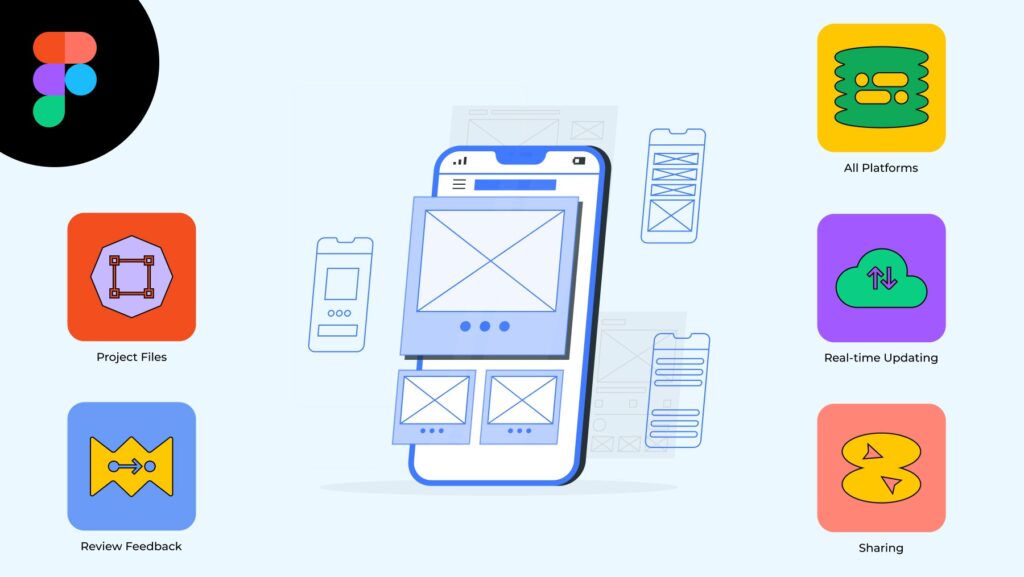5 Key Advantages of Using Figma as a Design Tool

Design is evolving every passing day. With the availability of many design tools out there, one may get overwhelmed in making the correct tool. However, this blog will help you make a choice for sure! Gone are the days to share zoom screens and work, now we just jump into Figma and magically everything connects and flows way better. Figma is a cloud-based UI and UX design tool. However, it is not similar to the rest of the design tools as it is better focused towards team collaboration. This blog will be mainly focused on how Figma simplifies the design process, and is effective in helping designers and teams to work together.
To start with, let’s talk about Figma as a design tool. It is a cloud computing based design tool that allows a team of designers to work together on the same file, without creating any hassle. This has a great impact on the overall cost of web and mobile application development for both clients and agencies as work gets done faster due to effective team collaboration. The development agencies also save in terms of their allocated design resources for a particular project. It is focused on achieving the most impeccable designs in the web/mobile business. It should not be forgotten that even though many other design tools are now using the team collaboration facility, figma was the first one to bring it in!
Here are five reasons why to choose Figma as a design tool for your clients. The features of figma are best-suited for organizations that require design tools for better delivery of work, and a hassle-free internal process of achieving it.
Figma Works on all Platforms
Figma may be used on any computer that has a web browser. Be it a Mac, Windows PC, Linux device, or even a Chromebook. It’s the only design tool of its kind that achieves this, and Figma files can still be shared, opened, and edited in shops with hardware running multiple operating systems.
Designers and developers are utilising Mac and Windows PCs in numerous workplaces. Figma assists in bringing these disparate groups together. The universal nature of Figma also eliminates the nuisance of PING-pong (that bounces back and forth between the updated images and the design team). There is no need for a middle-app when using Figma to make design work accessible to everyone.
Embedded Figma Files Provide Real-time Updating
Figma also provides live embed code snippets that may be used to put an I Frame into third-party applications. If Confluence is used to show integrated prototype files, those files ARE the actual updated Figma files.
In simpler terms, if any of your team members make a change to the prototype, that very change can be seen by the entire team using Figma through the embedded Confluence mockup. This really helps the team to be aware of any changes that are being made to files, as well as for them all to remain on the same page.
Figma is Great for Design Review Feedback
Out of all design and prototype mechanisms, Figma offers an in-app commenting feature, and the comment thread is monitored in Slack and/or email. To gather input from a team utilising a third-party application like InVision or Marvel, there’s no need to publish PNG files or do regular updates as a result of this feature.
The design team can then discuss their work and updates on a wide screen during design reviews. This doesn’t end here, they can also record comments, and address errors all in Figma. This type of real-time feedback is not usually found in other applications, as they mostly require team input to be uploaded to a cloud server.
Project Files in Figma Reside at One Place
Another perk that comes with using Figma is that it manages file organization by showing projects and associated files in a dedicated window, since it is an online software. Figma also allows Agile teams to arrange their projects logically by allowing several pages per file.
The teams can do so reasonably by either creating projects for a specific theme, or creating files for an epic project, or they can create separate pages within a file for each user story. These were just a few examples of how Figma can be used to organize files. However, it is not limited to these options alone as the final call would depend on the process and interface.
Figma Sharing Is Uncomplicated and Flexible
Figma is simple! It also allows its users to share any file, page, or frame depending on permissions (usually referred to as an artboard in other design tools). When a user clicks on a share link to a frame on a page, a web version of Figma is launched, and a pixelated view of the frame is loaded.
Within bug-monitoring systems and community software like Confluence or SharePoint, this type of precise sharing allowed by Figma, that shares a file to frame, allows designers, company executives, and developers to share just what is needed.
Conclusion:
The design community has many options to choose from, however, if you’re smart, you would’ve understood why Figma is a better choice amongst all. Be it its feature of offering several plans to choose from, or the ability to increase its functionality through built-in plugins.
Companies that are truly concerned about what they are delivering to their customers are very much keen to have a design software that ensures the quality of their work. Using Figma would ensure that the quality of in-house design is intact because of its inbuilt feedback feature, and the real-time update feature.










